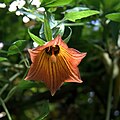Canarina canariensis
| Canarina canariensis | |
|---|---|

| |
| Scientific classification | |
| Kingdom: | Plantae |
| Clade: | Tracheophytes |
| Clade: | Angiosperms |
| Clade: | Eudicots |
| Clade: | Asterids |
| Order: | Asterales |
| Family: | Campanulaceae |
| Genus: | Canarina |
| Species: | C. canariensis
|
| Binomial name | |
| Canarina canariensis Vatke | |
Canarina canariensis is a
family
Campanulaceae, commonly known as the Canary Island bellflower, and known locally as bicácaro.
Description
It is a scrambling
. Flowers are axillary, solitary, bell-shaped, 3–6 cm long, orange (darkening when dried). It has a thick tuberous root, from which hollow, scrambling stems about 3 m are produced each year.The fruit is a large ovate, fleshy berry, orange when ripe, and edible.[1]
The species is bird pollinated by passerine species such as the chiffchaff.[2]
Distribution
Canarina canariensis is endemic to the Canary Islands.
- 300–1000 m, local in the south of the island.
- San Mateo, Santa Brigida, Pino Santo, Teroretc.
- La Palma: Mazo, Los Tilos, Barranco Nogales etc., open areas in laurel forests or forest relicts.
- La Gomera: Rare in the forest regions.
- El Hierro: Frontera, las Playas etc.[3]
Cultivation
This species is valued in cultivation for its scrambling habit and attractive deep orange bell flowers. As it does not tolerate temperatures below 0 °C (32 °F), in temperate regions it must be grown under glass. It can be expected to reach 1.5 metres (4.9 ft) in height. In cultivation in the UK it has gained the Royal Horticultural Society’s Award of Garden Merit.[4]
Gallery
-
Seeds
-
Tuberous root
-
Tuberous root
References
- ISBN 978-3-11-010661-9. Retrieved 31 July 2013.
- S2CID 12613534.
- ISBN 978-84-7207-129-2.
- ^ "RHS Plantfinder - Canarina canariensis". Retrieved 12 January 2018.
















